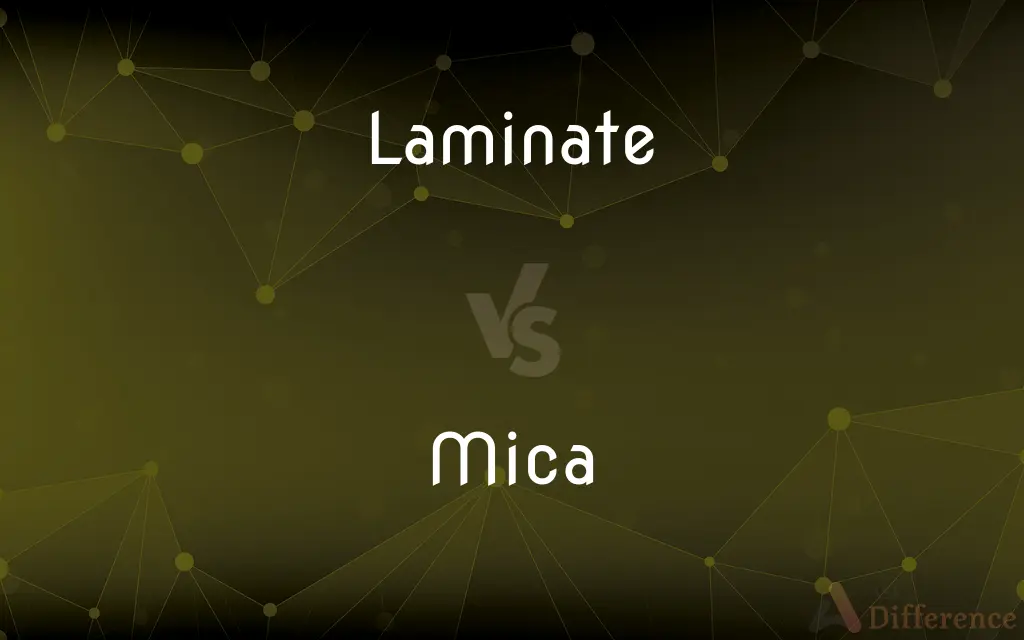Laminate vs. Mica — What's the Difference?
By Tayyaba Rehman & Maham Liaqat — Updated on March 19, 2024
Laminate is a synthetic material made by pressing together layers of paper and plastic resins, widely used for durable, affordable surfaces. Mica, a natural mineral, is used for its insulation properties and aesthetic appeal in electronics, & cosmetics.

Difference Between Laminate and Mica
Table of Contents
ADVERTISEMENT
Key Differences
Laminate, often used in furniture and countertops, is celebrated for its versatility and ability to mimic the appearance of wood, stone, or other textures. It's manufactured through a high-pressure process that combines multiple layers of paper with a resin, creating a durable and resistant surface. Mica, on the other hand, is a naturally occurring group of silicate minerals known for their layered structure, which can be separated into thin sheets. These sheets are valued for their thermal insulation properties, electrical resistance, and unique glittery appearance.
The durability of laminate makes it a popular choice for high-traffic areas in homes and commercial spaces. Its ability to resist scratches, stains, and heat contributes to its widespread use in kitchen countertops, cabinets, and flooring. Mica's durability is different; it's prized for its electrical insulation and heat resistance, making it essential in electrical components, heaters, and even as a substrate in laboratory microscopes.
Aesthetically, laminate offers a broad range of finishes, patterns, and colors, allowing for design flexibility in interior decorating. It can be engineered to look like more expensive materials at a fraction of the cost. Mica's aesthetic appeal lies in its natural sparkle and translucence, used to add shimmer in cosmetics and paints, and for decorative purposes in crafts and home decor.
The production process of laminate involves bonding under heat and high pressure, which is largely synthetic and requires energy-intensive manufacturing. In contrast, mica mining focuses on extracting the mineral from deposits, often done manually in some regions, raising concerns about labor practices and environmental impact.
In terms of cost, laminate is generally more affordable and accessible, making it a popular choice for budget-conscious consumers looking for durability and style. Mica's cost can vary widely based on its quality, type, and application, with some forms being relatively inexpensive, while high-quality sheets used in electronics and industrial applications may be costlier.
ADVERTISEMENT
Comparison Chart
Composition
Synthetic (paper and resin)
Natural mineral (silicate)
Uses
Furniture, countertops, flooring
Electrical insulation, cosmetics, decoration
Durability
Resistant to scratches, stains, and heat
High thermal and electrical resistance
Aesthetic
Wide range of finishes, mimics other materials
Natural sparkle and translucence
Production Process
Bonding under heat and pressure
Mining and separation into sheets
Cost
Generally affordable
Varies, can be more expensive based on quality
Compare with Definitions
Laminate
Available in various patterns and colors.
Laminate countertops can mimic granite or marble.
Mica
Heat resistant and electrically insulating.
Mica is crucial in manufacturing heat-resistant cables.
Laminate
Resistant to everyday wear and tear.
Laminate tables are ideal for busy family kitchens.
Mica
Varies by type and application, sometimes expensive.
High-quality mica is prized in electronics for its properties.
Laminate
A durable, synthetic surface material for interiors.
Laminate flooring offers a cost-effective hardwood alternative.
Mica
A silicate mineral used for insulation and decoration.
Mica sheets are used in electrical insulators.
Laminate
More affordable than natural material alternatives.
Choosing laminate cabinets can lower renovation costs.
Mica
Obtained through mining, often manually.
Mica mining is labor-intensive and has environmental impacts.
Laminate
Easy to clean and maintain.
Spills on laminate can be wiped away without staining.
Mica
Adds shimmer to cosmetics and paints.
Mica powder is used in eyeshadow for its glittery effect.
Laminate
To cover with a thin sheet of material, as for preservation.
Mica
Micas ( MY-kəz) are a group of minerals whose outstanding physical characteristic is that individual mica crystals can easily be split into extremely thin elastic plates. This characteristic is described as perfect basal cleavage.
Laminate
To beat or compress (metal) into a thin plate or sheet.
Mica
A shiny silicate mineral with a layered structure, found as minute scales in granite and other rocks, or as crystals. It is used as a thermal or electrical insulator.
Laminate
To divide into thin layers.
Mica
Any of a group of chemically and physically related aluminum silicate minerals, common in igneous and metamorphic rocks, characteristically splitting into flexible sheets used in insulation and electrical equipment.
Laminate
To make by uniting several layers.
Mica
(mineral) Any of a group of hydrous aluminosilicate minerals characterized by highly perfect cleavage, so that they readily separate into very thin leaves, more or less elastic.
Laminate
To split into thin layers or sheets.
Mica
The name of a group of minerals characterized by highly perfect cleavage, so that they readily separate into very thin leaves, more or less elastic. They differ widely in composition, and vary in color from pale brown or yellow to green or black. The transparent forms are used in lanterns, the doors of stoves, etc., being popularly called isinglass. Formerly called also cat-silver, and glimmer.
Laminate
Consisting of, arranged in, or covered with laminae.
Mica
Any of various minerals consisting of hydrous silicates of aluminum or potassium etc. that crystallize in forms that allow perfect cleavage into very thin leaves; used as dielectrics because of their resistance to electricity
Laminate
A laminated product, such as plywood.
Laminate
A thin sheet of material, or the material itself, such as plastic, used to laminate something.
Laminate
To assemble from thin sheets glued together.
Laminate
To cover something flat, usually paper, in adhesive protective plastic.
We laminated the printouts so we could use them as signage.
Laminate
To form, as metal, into a thin plate, as by rolling.
Laminate
To cause to separate into thin plates or layers; to divide into thin plates.
Laminate
Material formed of thin sheets glued together.
Laminate
Consisting of, or covered with, laminae, or thin plates, scales, or layers, one over another; laminated.
Laminate
Consisting of, or covered with, laminæ, or thin plates, scales, or layers, one over another; laminated.
Laminate
To cause to separate into thin plates or layers; to divide into thin plates.
Laminate
To form, as metal, into a thin plate, as by rolling.
Laminate
To form by uniting two or more layers (in sheet form) of a material, so that the layers are bonded tightly.
Laminate
To unite (layers in sheet form) by bonding, so as to create a single object with multiple layers; - used with the material in sheet form as the object; as, to laminate plywood.
Laminate
To separate into laminæ.
Laminate
A sheet of material made by bonding two or more sheets or layers
Laminate
Create laminate by putting together several thin sheets of a material
Laminate
Press or beat (metals) into thin sheets
Laminate
Cover with a thin sheet;
Laminate the table
Laminate
Split (wood) into thin sheets
Common Curiosities
How do you clean laminate surfaces?
Laminate surfaces can be easily cleaned with a damp cloth and mild detergent, avoiding abrasive cleaners.
Can laminate look like real wood?
Yes, laminate can be engineered to closely mimic the appearance of real wood, along with other materials like stone.
Why is mica used in electrical components?
Mica is used because of its excellent thermal insulation and electrical resistance properties.
Is mica environmentally friendly?
The environmental impact of mica depends on mining practices; concerns include labor practices and habitat disruption.
What are the benefits of using mica in cosmetics?
Mica provides a natural shimmer and sparkle, enhancing the aesthetic appeal of cosmetics.
Are there ethical concerns with mica mining?
Yes, ethical concerns include child labor and poor working conditions in some mica-mining regions.
How durable is laminate compared to natural materials?
Laminate is highly durable and resistant to scratches, stains, and heat, though it may not match the longevity of some natural materials.
What's the cost difference between laminate and mica products?
Laminate products are generally more affordable, while mica products can vary in price, sometimes being more expensive due to extraction and quality.
What is laminate made of?
Laminate is made of multiple layers of paper and plastic resins pressed together under high heat and pressure.
Can mica be used in home decor?
Yes, mica is used in home decor for its glittery appearance, in items like wallpaper and decorative accents.
Share Your Discovery

Previous Comparison
Crate vs. Box
Next Comparison
Name vs. SignatureAuthor Spotlight
Written by
Tayyaba RehmanTayyaba Rehman is a distinguished writer, currently serving as a primary contributor to askdifference.com. As a researcher in semantics and etymology, Tayyaba's passion for the complexity of languages and their distinctions has found a perfect home on the platform. Tayyaba delves into the intricacies of language, distinguishing between commonly confused words and phrases, thereby providing clarity for readers worldwide.
Co-written by
Maham Liaqat














































